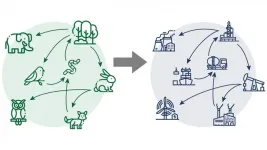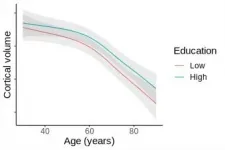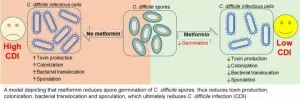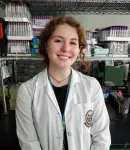Material scientists find new angle toward better heat transfer
UCLA Researchers developed a new class of optical material that can beam thermal radiation to specific directions over a broad spectrum.
2021-04-27
(Press-News.org) UCLA materials scientists have developed a class of optical material that controls how heat radiation is directed from an object. Similar to the way overlapping blinds direct the angle of visible light coming through a window, the breakthrough involves utilizing a special class of materials that manipulates how thermal radiation travels through such materials.
Recently published in Science, the advance could be used to improve the efficiency of energy-conversion systems and enable more effective sensing and detection technologies.
"Our goal was to show that we could effectively beam thermal radiation -- the heat all objects emanate as electromagnetic waves -- over broad wavelengths to the same direction," said study leader Aaswath Raman, an assistant professor of materials science and engineering at the UCLA Samueli School of Engineering. "This advance offers new capabilities for a range of technologies that depend on the ability to control the flows of heat in the form of thermal radiation. This includes imaging and sensing applications that rely on thermal sources or detecting them, as well as energy applications such as solar heating, waste heat recovery and radiative cooling, where restricting the directionality of heat flow can improve performance. "
Every object emits heat as light, a phenomenon known as thermal radiation. Familiar examples include the filament in a light bulb, glowing coils in a toaster and even the natural light from the sun. This phenomenon also can be detected on our skin and in common objects -- from the clothes you're wearing to the walls around you.
On Earth, for objects at ambient temperatures to modestly hot objects, much of the emitted thermal radiation resides in the infrared part of the spectrum.
Previously, a fundamental challenge had prevented materials from directing their heat in specific directions over a broad spectrum to ensure a sufficient amount of heat is emitted. To solve the puzzle, the researchers created a new theoretical framework using nanophotonic materials. For the first time, the team demonstrated that this new class of effective materials allows broad bands of thermal radiation to disperse over predetermined angles.
"To demonstrate this concept, we layered several oxide materials, that each manipulate infrared light over different wavelengths, and beamed much of the emitted heat toward the same fixed angles, " said the study's first author Jin Xu, a UCLA materials science and engineering graduate student. "Additionally, the oxides we used are common, so supplies would not be a problem in the production of the material. "
The class of materials that directs heat is known as "epsilon-near-zero" or ENZ materials. The researchers call their new material a gradient ENZ material. They demonstrated two such material samples that can beam thermal radiation over broad bandwidths to narrow bands of angles -- from 60° to 75° and 70° to 85° respectively.
Using a thermal imaging camera, the radiation angles could be seen looking at silicon wafers coated with the gradient ENZ materials. Viewed from most angles, the heated discs appeared to be cold, similar to how polished metals such as aluminum look under a thermal camera. However, when viewed at the designed specific angles, the higher-heat signatures could be spotted on the discs.
INFORMATION:
The research was supported by the Sloan Research Fellowship in Physics from the Alfred P. Sloan Foundation.
UCLA postdoctoral scholar Jyotirmoy Mandal is the paper's other author. Mandal is supported by the Schmidt Science Fellows program, a partnership with University of Oxford's Rhodes Trust.
[Attachments] See images for this press release:

ELSE PRESS RELEASES FROM THIS DATE:
2021-04-27
By translating the pattern of interconnections between nature's food chains to industrial networks, researchers at Texas A&M University have delineated guidelines for setting up successful industrial communities. The researchers said this guidance can facilitate economic growth, lower emissions and reduce waste while simultaneously ensure that partnering industries can recover from unexpected disturbances.
"Industries can often partner up to exchange byproducts and over time these industries might form bigger communities. While these networks sound quite beneficial to all industry partners within the community, they are not always successful," said Dr. Astrid Layton, assistant professor in the J. Mike Walker' ...
2021-04-27
"This finding suggests that higher education does not influence brain aging" says Lars Nyberg from Umeå University in Sweden, first author of the study and also a part of the Lifebrain consortium.
Brains shrink at the same rate
All brains shrink with age, and the dominant view has been that more education slows the rate of shrinking. However, the evidence has been inconclusive because studies have not been able to track the rate of change over time. Until now.
Measured brain shrinkage over time
The researchers measured brain aging by measuring the ...
2021-04-27
EUGENE, Ore. -- April 27, 2021 -- The addition of meat alternatives such as poultry and fish is not reducing the global production and consumption of energy-gobbling land-based meats, according to new research.
That conclusion comes from an analysis of 53 years of international data by University of Oregon sociologist Richard York, who focuses on energy consumption in relationship to economic issues such as power and inequalities, and politics. His findings published April 26 in the journal Nature Sustainability.
"If you have increases in the production of poultry and fish, it doesn't tend to compete with or suppress other meat source consumption," York said. "It would be great if more ...
2021-04-27
Shopping habits and escalating consumption of many consumers are inflicting a heavy environmental toll, and while the majority of customers seem hesitant to act "green" on their own, companies are increasingly expected to implement effective eco-friendly tactics. But efforts to increase towel reuse at hotels, paperless adoption in the banking industry or "ugly" food consumption at grocery stores have been challenging.
As a result, millions of tons of cosmetically imperfect produce are wasted every year in the United States while about one billion trees worth of paper are thrown away. Electricity consumption ...
2021-04-27
An international, multidisciplinary team that includes faculty members from The University of Texas at Arlington has published a paper in the journal Philosophical Psychology that wades into the debate about whether fish feel pain.
Their conclusion: while fish lack certain regions of the brain typically associated in humans with processing the unpleasantness of pain, this does not offer definitive proof that fish don't experience painful events.
There is a divide among contemporary scientists and philosophers on the issue of animal suffering, particularly in fish. Following the discovery of pain receptors in fish in the early 21st century, scientists developed behavioral experiments that seemed to show that fish ...
2021-04-27
Rockville, Md. (April 27, 2021)--Deep heat creams widely used by athletes to soothe sore muscles may also boost performance when applied before exercise, according to new research presented virtually this week at the American Physiological Society's (APS) annual meeting at Experimental Biology 2021.
Researchers at Nanyang Technological University in Singapore studied a small group of male volunteers to determine the effects of deep heat cream on exercise endurance. Each volunteer participated in two trials--one where he applied a thin layer of a commercially available ...
2021-04-27
Rockville, Md. (April 27, 2021)--Researchers from Wake Forest School of Medicine in North Carolina have demonstrated that a common diabetes drug inhibits the spread of Clostridioides difficile, or C. diff--a potentially life-threatening infection commonly acquired during hospital stays. The team will present their work virtually at the American Physiological Society's (APS) annual meeting at Experimental Biology 2021.
C. diff is the most common hospital-acquired infection in the U.S. It starts in the intestines, often after a course of antibiotics. The Centers for Disease Control and Prevention categorizes the bacteria C. diff as a public health threat that "require[s] urgent and aggressive action." In 2017, ...
2021-04-27
Rockville, Md. (April 27, 2021)--The popular herbicide Roundup® has been in the news because of concerns its main ingredient, glyphosate, might cause cancer. Now researchers from Florida Atlantic University (FAU) are evaluating the pesticide for potential neurological impacts. This week, the scientists will present their work virtually at the American Physiological Society's (APS) annual meeting at Experimental Biology 2021.
The roundworm Caenorhabditis elegans (C. elegans) is a microscopic worm that lives in soil and feeds on bacteria. Scientists have studied it extensively since the 1960s to better understand fundamental physiological processes of the animal kingdom. Because roughly 38% of its genes have counterparts in humans, findings ...
2021-04-27
Rockville, Md. (April 27, 2021)--High-intensity cycling in very short bursts can lead to performance and health benefits in just 10 minutes a day, according to a new study to be presented virtually this week at the American Physiological Society's (APS) annual meeting at Experimental Biology 2021.
Young adult volunteers participated in high-intensity cycling three times a week for eight weeks. They cycled at maximum effort for four seconds and rested for 15 to 30 seconds before beginning another four-second sprint. Each sprint-rest bout was repeated up to 30 times in a single workout session, for a total of 10 minutes.
By the end of the trial ...
2021-04-27
Rockville, Md. (April 27, 2021)--A new study by researchers at the VA Portland Health Care System in Oregon found that augmenting traditional treatment for traumatic brain injury (TBI) with morning bright light therapy (MBLT) improved physical and mental symptoms for participants. The team will present their work virtually at the American Physiological Society's (APS) annual meeting at Experimental Biology 2021.
According to the U.S. Department of Veterans Affairs (VA), over 185,000 veterans have been diagnosed with at least one TBI. TBI is both a common and complex injury. Because of the circumstances surrounding the brain injury, TBI frequently coincides with posttraumatic stress disorder ...
LAST 30 PRESS RELEASES:
[Press-News.org] Material scientists find new angle toward better heat transfer
UCLA Researchers developed a new class of optical material that can beam thermal radiation to specific directions over a broad spectrum.






